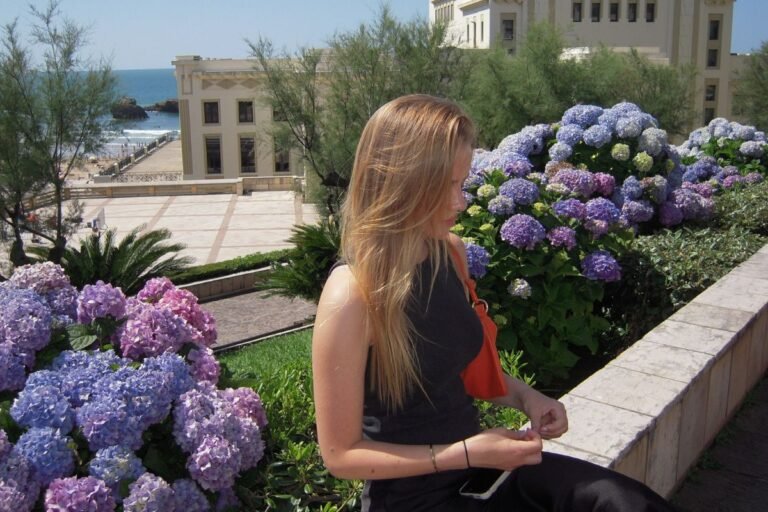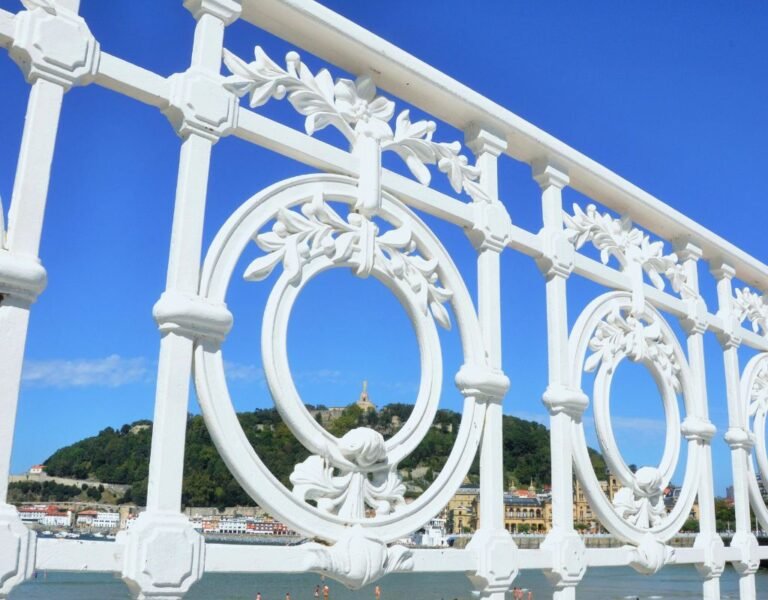Islamic Architecture in Spain: Moorish and Arab History
|
Are you planning on visiting some Islamic architecture in Spain? Read on to find out what to visit!
Living in Spain for the past few years has given my family and me the perfect opportunity to explore the country at our own pace. Road-tripping has become our favorite way to travel—it gives us the freedom to make spontaneous stops, discover hidden spots, and truly immerse ourselves in Spain’s rich history. And when we plan a longer trip, we always try to include at least one UNESCO Moorish monument.
Why? Because these places are more than just beautiful—they’re windows into a past where Al-Andalus was one of the most advanced civilizations in Europe. Walking through grand palaces, intricate courtyards, and ancient mosques-turned-cathedrals, it’s impossible not to feel a sense of awe.
These sites stand in stark contrast to anything we might see in the U.S., making each visit not just a sightseeing stop but a powerful learning experience.
From the mesmerizing arches of the Great Mosque of Córdoba to the intricate tile work of the Alhambra, we’ve explored every monument listed below. Spain’s Islamic heritage is definitely something you won’t want to miss.
Lets take a look at these not-so-hidden gems so that you know exactly where to go during your next visit to Spain.
A Quick Look at the Best Spanish Islamic Architecture
- Alhambra Palace, Granada
- The Mezquita (Great Mosque), Córdoba
- La Giralda, Sevilla
- Aljaferia, Zaragoza
- St. Mary’s Cathedral, Granada
- Alcazaba, Malaga
- Torre del Oro, Seville
- The Real Alcázar, Seville
- Cristo de la Luz, Toledo
- Calahorra Tower, Córdoba
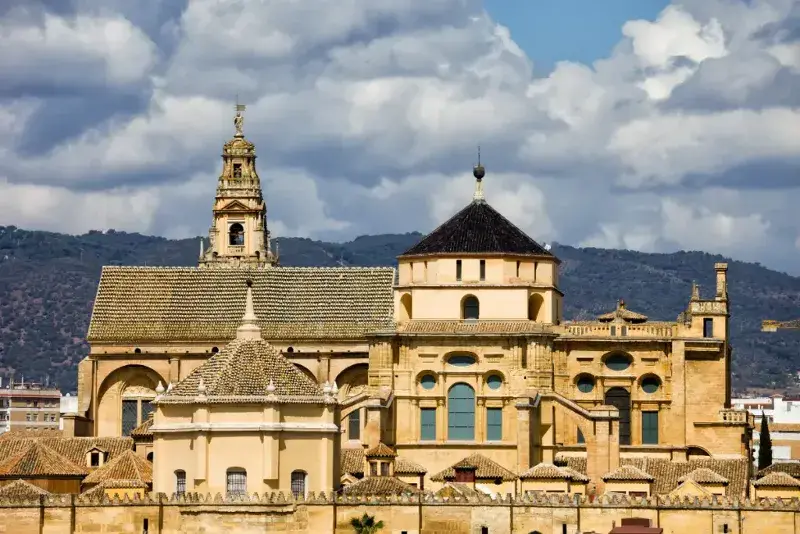
The Roots Of Islamic Architecture in Spain
Islamic architecture in Spain can be traced back to the rule of the Moors during the Middle Ages. Following their conquest and settlement in Spain, the Moors colonized specific regions. Their architectural contributions included the construction of massive forts for defense, mosques for worship, and impressive palaces for their leaders’ residences.
Evidence also suggests that they established quarries in the Sierra Nevada region near Granada as a source of materials for building their numerous masterpieces. The presence of Islamic architecture in Spain is a testament to the rich historical and cultural influences of the Moors in the region.
While Christians gradually took political control from Muslims in medieval Spain, the cultural impact of al-Andalus remained everpresent. Islamic architectural influence was so profound that non-Muslims started incorporating it into their religious buildings.
The term “Mudéjar” describes Islamic-style art and architecture created post-Christian conquest. Even in modern times, Spanish buildings continue traditions rooted in the explosive growth of al-Andalus over a thousand years ago.
Top Spanish Islamic Architecture
Traces of Islamic architecture in Spain are widespread, with the highest concentration found in the eight provinces in Andalucia. In these regions, you’ll discover numerous examples of Moorish architecture that showcase the enduring influence of Islamic culture on Spain’s built environment.
1. Alhambra Palace, Granada
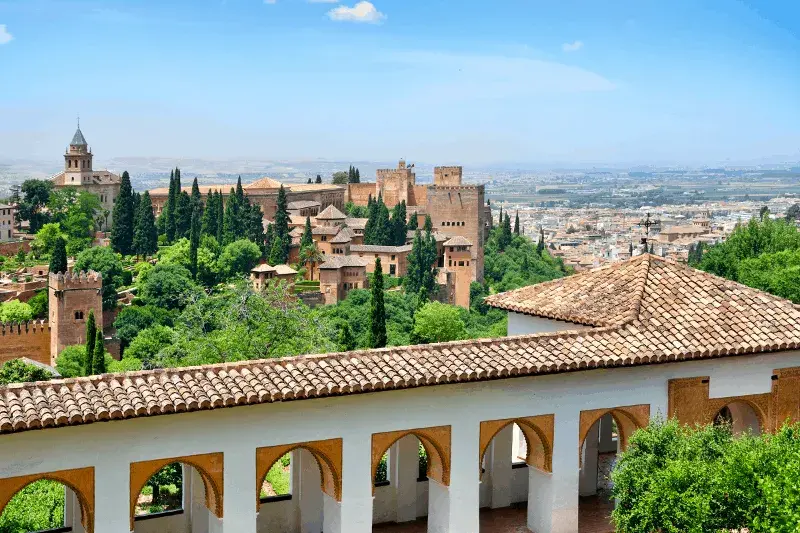
The Alhambra Palace in Granada stands as one of the finest showcases of Islamic architecture globally. It is positioned on a hill overlooking the Albayzin, the old Arabic Quarter of Granada, with the Sierra Nevada mountains as a striking backdrop. The palace complex is so big that you will require at least a day to explore.
Within the Alhambra, you’ll encounter a comprehensive array of Moorish architectural features. These include horseshoe arches, Arabesque and Muqarba ceiling designs, reflective pools, calligraphy, and beautifully landscaped gardens. Other places you must see during your visit are the Nasrid Palaces, Court of the Myrtles, Partal Palace, and the Generalife Gardens.
2. The Mezquita (Great Mosque), Córdoba

The Mezquita in Córdoba stands as a unique testament to the cultural richness that flourished during the era of Al-Andalus in the eighth century. Founded by Abd al-Rahman I, Córdoba became the center of a progressive society. The rulers, including Abd al-Rahman’s descendants, spread knowledge and brought innovations from Asia and Africa.
The Mezquita itself is an unparalleled architectural marvel. Rows of stacked arches connect a grid of marble columns that seem to stretch endlessly. Intricate stripes adorn the space in every direction. Here you can find a gilded dome, praised by modern engineers for its near-perfect geometry and has remained intact for over a millennium without needing repair.
Despite efforts by later Catholics to erase Muslim history, the Mezquita survived the Reconquista, becoming the only major mosque to endure. Instead of destruction, the middle section was transformed into a cathedral.
Surrounding the Mezquita, smaller structures adopted its detailed carvings and elaborate geometry. It is complete with narrow, whitewashed streets in Córdoba’s historic center. Notable medieval buildings, such as the Synagogue and the Capilla de San Bartolomé, continue to stand.
3. La Giralda, Sevilla
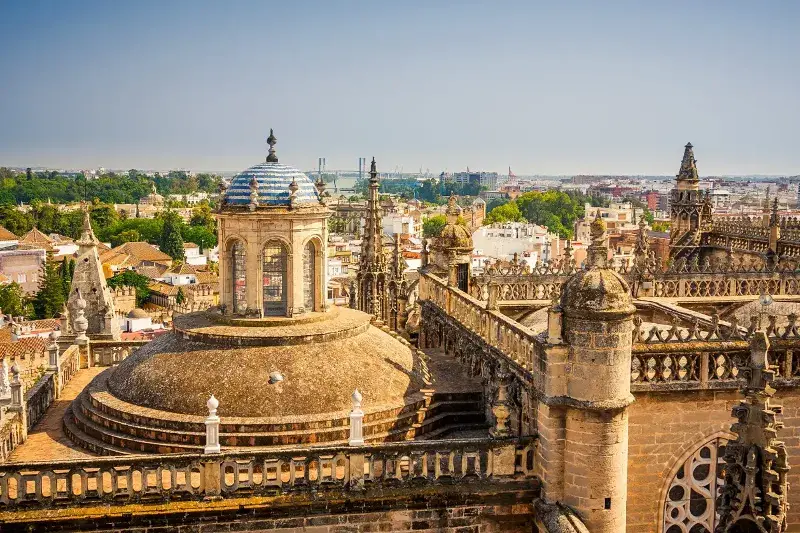
La Giralda, the bell tower adjacent to Seville Cathedral, is another impressive example of Moorish architecture, showcasing its grandeur even from the exterior. Marked by archways, latticework, and simulated balconies, this structure, constructed in the late 1100s, is believed to be inspired by the Koutoubia Mosque in Morocco.
While exploring La Giralda, you have the opportunity to go up to the observation platform, providing beautiful views of Seville. The surrounding landscape is really remarkable, featuring various Moorish elements such as an Almohad-style courtyard dotted with orange trees and a reflective pool.
4. Aljaferia, Zaragoza

Situated in the enchanting city of Zaragoza, Aljaferia Palace stands as one of the rare examples of Islamic architecture in northern Spain. Originally constructed in the 11th century as a leisure palace for the Taifas kings, it boasts remarkable remnants of Islamic carvings, botanical motifs, and Arabesques.
A visit to Troubadour Tower is a must, where horseshoe arches dating back to the 10th century can be admired. The Golden Hall, featuring intricately carved wooden ceilings and filigrees depicting birdlife, is something else you’ll want to see. The north side halls showcase impressive calligraphic and floral reliefs.
Take time to explore the serene courtyard of Santa Isabel, filled with intricate decorations and a topiary. Beyond its architectural splendor, Aljaferià Palace provides valuable insights into the evolving landscapes of Spain during the times of the Moors. This historical treasure allows visitors to appreciate the artistry and cultural nuances that have shaped the region.
5. St. Mary’s Cathedral, Granada

St. Mary’s Cathedral in Granada reflects the intertwining of Islamic and Christian influences during a revolutionary period in Spain’s history. Following the conquest of Granada by Catholic monarchs in the 15th century, the cathedral was conceived as a blend of the existing mosque’s Arabic elements and new Christian decorations.
Construction commenced in 1523 and concluded in 1704, symbolizing the transition from Islamic to Christian rule. The cathedral’s architectural diversity seamlessly fuses Renaissance, Gothic, and Baroque styles. St. Mary’s Cathedral is known for its stained glass windows, marble embellishments, and a striking Baroque-style main altar decorated with sculptures and artworks.
The royal chapels within the cathedral serve as the resting place for monarchs Ferdinand and Isabella, featuring unique architectural masterpieces with intricate wooden carvings. Legend has it that the decision to build the cathedral was taken after hearing a nightingale’s song while contemplating the mosque’s ruins.
6. Alcazaba, Malaga
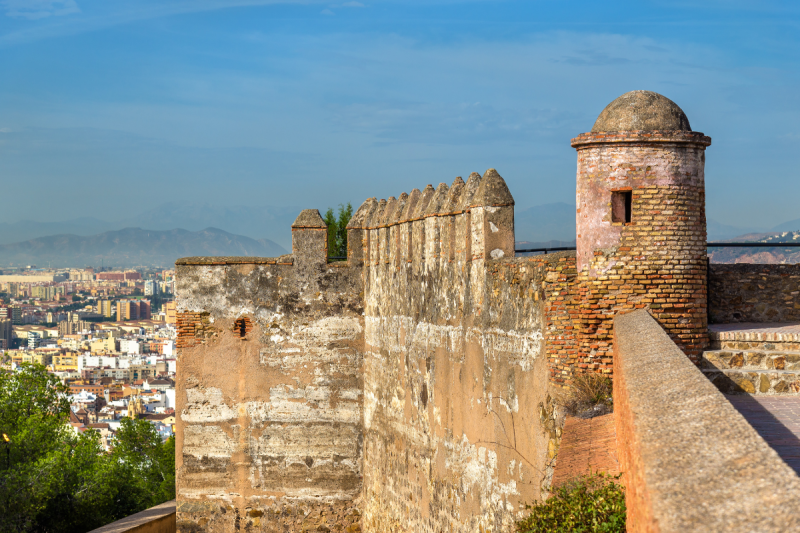
Constructed on a hill overlooking the sea in the coastal city of Malaga, the Alcazaba stands as a well-preserved Islamic gem. It is believed to have been constructed between the 11th and 14th centuries. Its unique history unfolds at the crossover of centuries and civilizations, featuring a 1st-century Roman amphitheater on-site and subsequent additions.
The Islamic influence is obvious throughout the Alcazaba, notably at the Puerta de las Columnas, where a horseshoe archway and the inner citadel are some of the distinctive architectural elements. The southern pavilion’s Taifa Palace has beautiful arches at its entrance, all carved with intricate Arabesque decorations too.
The Nasrid palace has several patios surrounded by reflective pools beneath the open sky. Exploring the Alcazaba is really a journey through time, which allows you to appreciate the rich architectural and cultural heritage left by various civilizations in this beautiful fortress overlooking the Mediterranean.
7. Torre del Oro, Seville

Seville’s Torre del Oro graces the shores of the Guadalquivir River and is lined with palm trees. It dates back to the early 1200s and was a creation of the Almohad Moors. Originally designed as a defense against river invaders, the Golden Tower has evolved into one of the most important landmarks in modern-day Seville.
Going up to the observation deck of the Torre del Oro you’ll get breathtaking views, while the Naval Museum is filled with model ships, maritime artifacts, and maps from historic expeditions to the Americas.
This well-preserved example of Moorish architecture adds a really interesting layer to Seville’s cultural landscape and can be easily incorporated into an itinerary that includes a visit to the Real Alcázar and La Giralda.
8. The Real Alcázar, Seville
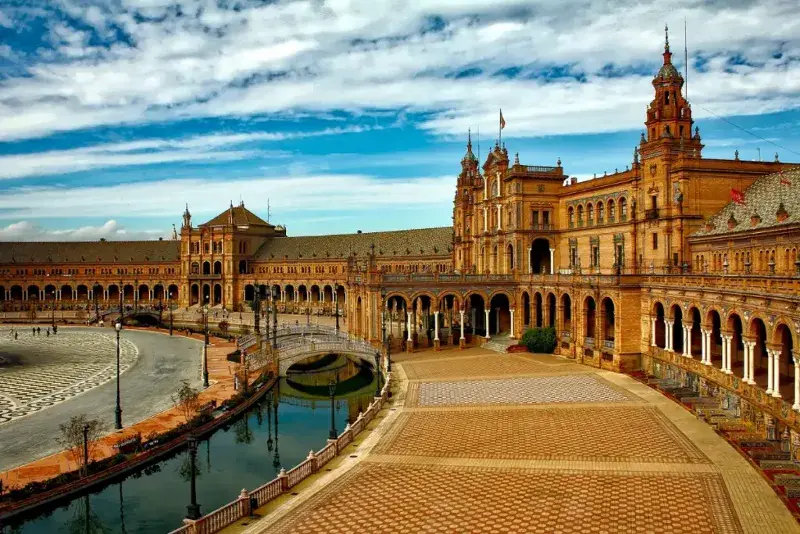
Seville, emerging as the dominant power after the collapse of Córdoba’s central government, showcases the Real Alcázar as a symbol of its historical prominence. Originally initiated by Islamic rulers in the 11th century, this palace underwent expansions by Christian kings in later centuries.
The Real Alcázar represents Moorish architecture, featuring intricate tile floors and elaborate ceiling layers. Surrounding the palace, a sequence of gardens begins with authentic Islamic patios and transitions into European-style landscapes.
Seville’s Islamic legacy can also be seen in landmarks such as La Giralda, repurposed from the main mosque’s minaret into a bell tower, and La Torre de Oro, a 12-sided defensive structure along the river. The influence of the Alcázar extends to the Casa de Pilatos, where Spanish nobility drew inspiration, incorporating similar tilework and carvings.
Additionally, the Bunhaira Gardens occupy the site of a Muslim-era estate, hosting a 19th-century Moorish-style palace and enriching the city’s cultural fabric with its Islamic heritage.
9. Cristo de la Luz, Toledo
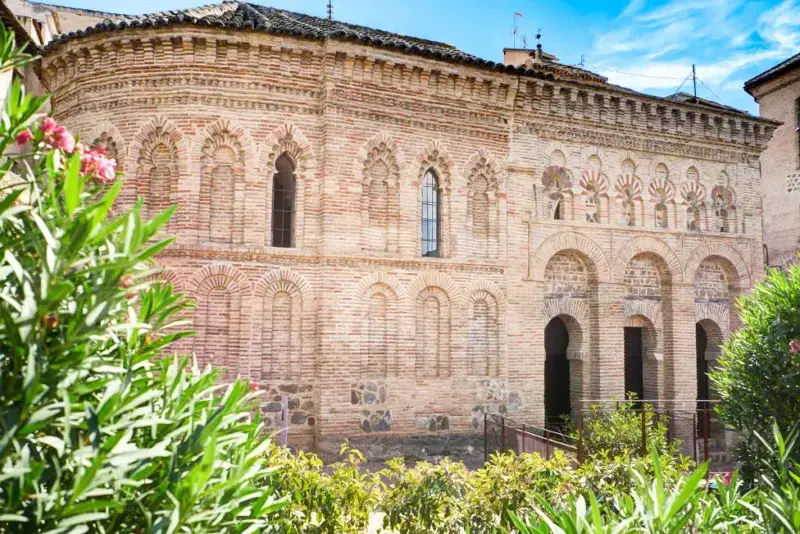
The Cristo de la Luz in Toledo, originally a mosque and now repurposed as a Catholic chapel, has roots dating back to the year 1000. Among the ten mosques that once graced Toledo, this structure stands as the sole survivor. It showcases well-preserved examples of Mudéjar architecture and art, which makes it a pivotal monument in the city.
Coming through the main door, you’ll find the inside decorated with ribbed vaults and horseshoe arches. Within the mosque, if you look carefully you’ll see inscriptions and plaster etchings dating back to the 10th century.
The architectural marvel, both inside and out, is a testament to engineering at the time, especially considering its enduring presence in the heart of a city surrounded by modern structures. The Cristo de la Luz is truly amazing considering how long its been standing.
Toledo is one of the best examples of Mudéjar architecture, having the most outside of Andalusia’s major cities. Despite falling under Christian rule in 1085, Toledo’s unique historical context meant that many different cultural groups interacted here. You can see this clearly in the architectural influences of Christianity, Judaism and Islam
10. Calahorra Tower, Córdoba
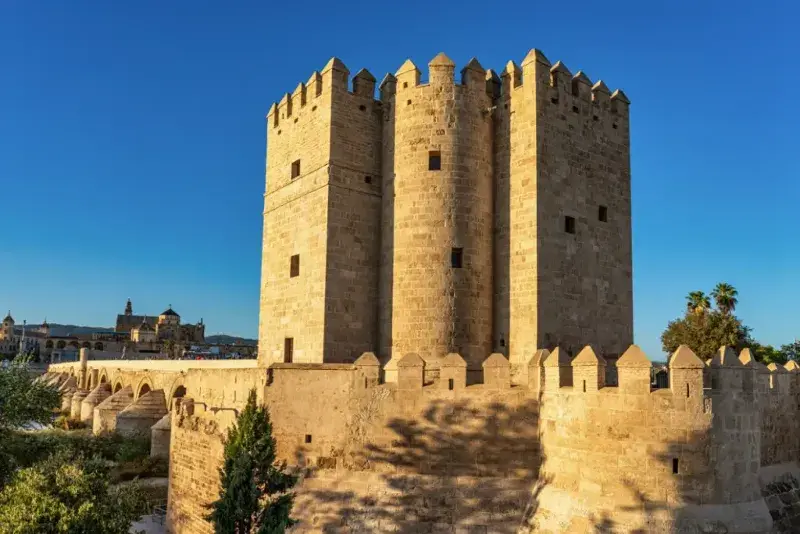
In the heart of Córdoba’s historic center, the Calahorra Tower stands as one of Andalucia’s renowned Islamic gates and towers. Originally constructed by the Almohads, its purpose was to safeguard the River Guadalquivir bridge. It offered a vantage point for spotting potential threats from a distance.
Positioned on the south side of the Roman bridge, this tower has served various functions since the 12th century, including stints as a prison and school. Today, visitors can cross the historic bridge, and imagine what it used to be like centuries ago.
A visit to the Living Museum of Al-Andalus gives you an opportunity to dive deeper into the fascinating history of the Moors during their rule in Spain. The Calahorra Tower not only stands as a link to Córdoba’s past but also offers a glimpse into the multifaceted roles it has played in the city’s history.
Islamic Architecture in Spain: FAQ
Which city in Spain has the most Islamic history?
Córdoba stands out as a city deeply rooted in Islamic history. During the 10th century, it was the capital of the Umayyad Caliphate in Al-Andalus and became one of the most advanced cities in the world.
The city was home to over 300 mosques and numerous palaces, reflecting its significance as a cultural, political, and economic center.
What happened to the mosques in Spain?
Following the Christian Reconquista, many mosques in Spain were repurposed or demolished. A notable example is the Great Mosque of Córdoba, which was converted into a cathedral in 1236.
This transformation was common, as new Christian rulers sought to assert their dominance by replacing Islamic places of worship with churches.
Which country has the best Islamic architecture?
Several countries boast outstanding Islamic architecture. Iran is renowned for its intricate mosques, like the Shah Mosque in Esfahan. Turkey showcases Ottoman masterpieces, including the Blue Mosque and Hagia Sophia. Morocco impresses with its ornate palaces and mosques in cities like Marrakesh and Fez.
Spain stands out for its Moorish gems, such as the Alhambra and the Great Mosque of Córdoba. Each country offers a unique perspective on the beauty and innovation of Islamic design.
Islamic Architecture in Spain: Conclusion
Intriguingly, the cities are not only rich in Muslim architecture but also happen to be among Spain’s most affordable places to live. This presents an enticing prospect for those contemplating an extended stay or relocation. Taking your time here will leave you with an immersive experience in these culturally vibrant locales without straining the budget.
For those traveling with family, Seville and Malaga emerge as particularly favorable choices, having been recognized among the best places to live in Spain. These cities offer a harmonious blend of culture, history, and a family-friendly atmosphere, creating an ideal setting for expat families to thrive.
Whichever path you decide to take, the captivating charm of Muslim architecture in Spain promises to leave you awe-inspired. May your journey be filled with exploration, cultural enrichment, and lasting memories. Happy travels!
Hello and Welcome!

We started our family travel blog in hopes of supporting other families move abroad and travel the world. Through straightforward, sincere and supportive information we hope to provide a reliable guide for those moving overseas with a family and traveling the globe.




